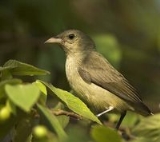
Flowerpecker
Encyclopedia
The flowerpeckers are a family
, Dicaeidae , of passerine
bird
s. The family comprises two genera, Prionochilus
and Dicaeum
, with 44 species in total. The family has sometimes been included in an enlarged sunbird
family Nectariniidae. The berrypeckers of the family Melanocharitidae
and the painted berrypeckers, Paramythiidae, were once lumped into this family as well. The family is distributed through tropical southern Asia and Australasia
from India
east to the Philippines
and south to Australia
. The family is catholic in its habitat preferences, occupying a wide range of environments from sea level to montane habitats. Some species, such as the Mistletoebird
of Australia, are recorded as being highly nomadic over parts of their range.
_with_a_muntingia_calabura_(singapur_cherry)_fruit_w_img_8784.jpg) There is little variation between species in the family. Flowerpeckers are stout birds, with short necks and legs. These are small birds ranging from the 10-cm, 5.7-gram Pygmy Flowerpecker
There is little variation between species in the family. Flowerpeckers are stout birds, with short necks and legs. These are small birds ranging from the 10-cm, 5.7-gram Pygmy Flowerpecker
to the 18-cm, 12-gram Mottled Flowerpecker
. Flowerpeckers have short tails, short thick curved bills and tubular tongues. The latter features reflect the importance of nectar in the diet of many species. They also have digestive systems that have evolved to deal efficiently with mistletoe
berries. They often dull in colour, although in several species the males have brightly patterned crimson or glossy-black plumage
.
 Nectar forms part of the diet, although they also take berries, spiders and insects. Mistletoes of 21 species in 12 genera have been found to be part of the diet of flowerpeckers, and it is thought that all species have adaptations to eat these berries and dispose of them quickly. Flowerpeckers may occur in mixed-species feeding flock
Nectar forms part of the diet, although they also take berries, spiders and insects. Mistletoes of 21 species in 12 genera have been found to be part of the diet of flowerpeckers, and it is thought that all species have adaptations to eat these berries and dispose of them quickly. Flowerpeckers may occur in mixed-species feeding flock
s with sunbirds and white-eye
s, as well as other species of flowerpecker.
The breeding biology of the flowerpeckers has been little studied. In the species where data has been collected they apparently form monogamous pairs for breeding, but the division of labour varies; in Scarlet-breasted Flowerpecker
s both parents participate in all aspects of nest building, incubation and chick rearing, but in the Mistletoebird
the female undertakes the first two tasks alone. Flowerpeckers lay 1-4 eggs, typically in a purse-like nest of plant fibres, suspended from a small tree or shrub. Recorded incubations times are scarce, but range from 10-12 days, with fledging occurring after 15 days.
The majority of flowerpeckers are resilient in their habits and are not threatened by human activities. Five species are considered to be near threatened by the IUCN, two are listed as vulnerable
and one, the Cebu Flowerpecker
, is listed as critically endangered
. The status of the enigmatic Spectacled Flowerpecker
is unknown. Habitat loss is the cause of the declines of these species.
Family (biology)
In biological classification, family is* a taxonomic rank. Other well-known ranks are life, domain, kingdom, phylum, class, order, genus, and species, with family fitting between order and genus. As for the other well-known ranks, there is the option of an immediately lower rank, indicated by the...
, Dicaeidae , of passerine
Passerine
A passerine is a bird of the order Passeriformes, which includes more than half of all bird species. Sometimes known as perching birds or, less accurately, as songbirds, the passerines form one of the most diverse terrestrial vertebrate orders: with over 5,000 identified species, it has roughly...
bird
Bird
Birds are feathered, winged, bipedal, endothermic , egg-laying, vertebrate animals. Around 10,000 living species and 188 families makes them the most speciose class of tetrapod vertebrates. They inhabit ecosystems across the globe, from the Arctic to the Antarctic. Extant birds range in size from...
s. The family comprises two genera, Prionochilus
Prionochilus
Prionochilus is one of two genera flowerpecker that make up the family Dicaeidae. The genus differs from the other flowerpecker genus, Dicaeum in having ten long primary feathers in the wing and in the character of its calls. A study comparing the calls of the two genera suggested that Prionochilus...
and Dicaeum
Dicaeum
Dicaeum is a genus of birds in the flowerpecker family, a group of passerines tropical southern Asia and Australasia from India east to the Philippines and south to Australia...
, with 44 species in total. The family has sometimes been included in an enlarged sunbird
Sunbird
The sunbirds and spiderhunters are a family, Nectariniidae, of very small passerine birds. There are 132 species in 15 genera. The family is distributed throughout Africa, southern Asia and just reaches northern Australia. Most sunbirds feed largely on nectar, but also take insects and spiders,...
family Nectariniidae. The berrypeckers of the family Melanocharitidae
Melanocharitidae
The Melanocharitidae, the berrypeckers and longbills, is a small bird family restricted to the forests of New Guinea. The family contains ten species in four genera...
and the painted berrypeckers, Paramythiidae, were once lumped into this family as well. The family is distributed through tropical southern Asia and Australasia
Australasia
Australasia is a region of Oceania comprising Australia, New Zealand, the island of New Guinea, and neighbouring islands in the Pacific Ocean. The term was coined by Charles de Brosses in Histoire des navigations aux terres australes...
from India
India
India , officially the Republic of India , is a country in South Asia. It is the seventh-largest country by geographical area, the second-most populous country with over 1.2 billion people, and the most populous democracy in the world...
east to the Philippines
Philippines
The Philippines , officially known as the Republic of the Philippines , is a country in Southeast Asia in the western Pacific Ocean. To its north across the Luzon Strait lies Taiwan. West across the South China Sea sits Vietnam...
and south to Australia
Australia
Australia , officially the Commonwealth of Australia, is a country in the Southern Hemisphere comprising the mainland of the Australian continent, the island of Tasmania, and numerous smaller islands in the Indian and Pacific Oceans. It is the world's sixth-largest country by total area...
. The family is catholic in its habitat preferences, occupying a wide range of environments from sea level to montane habitats. Some species, such as the Mistletoebird
Mistletoebird
The Mistletoebird is a species of flowerpecker native to most of Australia , and also to the eastern Maluku Islands of Indonesia in the Arafura Sea between Australia and New Guinea. They also must live where there are trees and shrubs, so that they can build their nests...
of Australia, are recorded as being highly nomadic over parts of their range.
_with_a_muntingia_calabura_(singapur_cherry)_fruit_w_img_8784.jpg)
Pygmy Flowerpecker
The Pygmy Flowerpecker is a species of bird in the Dicaeidae family.It is endemic to the Philippines.Its natural habitats are subtropical or tropical moist lowland forests and subtropical or tropical moist montane forests....
to the 18-cm, 12-gram Mottled Flowerpecker
Mottled Flowerpecker
The White-mottled Flowerpecker or Mottled Flowerpecker is a species of bird in the Dicaeidae family. It is endemic to Makira in the Solomon Islands. Its inhabits primary forest and secondary growth, most commonly in the mountains.-References:* BirdLife International 2004. . Downloaded on 25...
. Flowerpeckers have short tails, short thick curved bills and tubular tongues. The latter features reflect the importance of nectar in the diet of many species. They also have digestive systems that have evolved to deal efficiently with mistletoe
Mistletoe
Mistletoe is the common name for obligate hemi-parasitic plants in several families in the order Santalales. The plants in question grow attached to and within the branches of a tree or shrub.-Mistletoe in the genus Viscum:...
berries. They often dull in colour, although in several species the males have brightly patterned crimson or glossy-black plumage
Plumage
Plumage refers both to the layer of feathers that cover a bird and the pattern, colour, and arrangement of those feathers. The pattern and colours of plumage vary between species and subspecies and can also vary between different age classes, sexes, and season. Within species there can also be a...
.

Mixed-species feeding flock
A mixed-species feeding flock, also termed a mixed-species foraging flock, mixed hunting party or informally bird wave, is a flock of usually insectivorous birds of different species, that join each other and move together while foraging...
s with sunbirds and white-eye
White-eye
White-eye can refer to:*White-eye , a large family of birds.*White-eye , a species of fish.*White-eye mutation, a mutation in Drosophila melanogaster linked to the X chromosome, found by reciprocal cross breeding experiments in 1906.*A lioness member of the Marsh Pride of lions that have featured...
s, as well as other species of flowerpecker.
The breeding biology of the flowerpeckers has been little studied. In the species where data has been collected they apparently form monogamous pairs for breeding, but the division of labour varies; in Scarlet-breasted Flowerpecker
Scarlet-breasted Flowerpecker
The Scarlet-breasted Flowerpecker is a species of bird in the Dicaeidae family.It is found in Brunei, Indonesia, Malaysia, and Thailand....
s both parents participate in all aspects of nest building, incubation and chick rearing, but in the Mistletoebird
Mistletoebird
The Mistletoebird is a species of flowerpecker native to most of Australia , and also to the eastern Maluku Islands of Indonesia in the Arafura Sea between Australia and New Guinea. They also must live where there are trees and shrubs, so that they can build their nests...
the female undertakes the first two tasks alone. Flowerpeckers lay 1-4 eggs, typically in a purse-like nest of plant fibres, suspended from a small tree or shrub. Recorded incubations times are scarce, but range from 10-12 days, with fledging occurring after 15 days.
The majority of flowerpeckers are resilient in their habits and are not threatened by human activities. Five species are considered to be near threatened by the IUCN, two are listed as vulnerable
Vulnerable species
On 30 January 2010, the IUCN Red List of Threatened Species identified 9694 Vulnerable species, subspecies and varieties, stocks and sub-populations.-References:...
and one, the Cebu Flowerpecker
Cebu Flowerpecker
The Cebu Flowerpecker is a small passerine bird. It is endemic to Cebu Island in the Philippines.The Cebu Flowerpecker is a critically endangered breeding bird...
, is listed as critically endangered
Critically endangered
Version 2010.3 of the IUCN Red List of Threatened Species identified 3744 Critically Endangered species, subspecies and varieties, stocks and subpopulations.Critically Endangered by kingdom:*1993 Animalia*2 Fungi*1745 Plantae*4 Protista-References:...
. The status of the enigmatic Spectacled Flowerpecker
Spectacled Flowerpecker
The Spectacled Flowerpecker is a new species of bird discovered in the forests of north-eastern Borneo in June 2009 and apparently belonging to the flowerpecker family Dicaeidae...
is unknown. Habitat loss is the cause of the declines of these species.
External links
- Flowerpecker videos on the Internet Bird Collection

